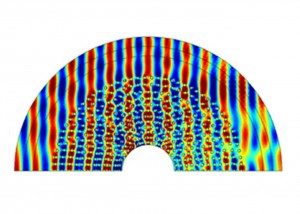 Researchers
Researchers
Elena Semouchkina, Professor, Electrical and Computer Engineering
Sponsor: National Science Foundation
Amount of Support: $337,217
Duration of Support: 3 years
Non-Technical Description: Transformation optics (TO) is based on coordinate transformations, which require proper spatial dispersions of the media parameters. Such media force electromagnetic (EM) waves, moving in the original coordinate system, to behave as if they propagate in a transformed coordinate system. Thus TO introduces a new powerful technique for designing advanced EM devices with superior functionalities. Coordinate transformations can be derived for compressing, expanding, bending, or twisting space, enabling designs of invisibility cloaks, field concentrators, perfect lenses, beam shifters, etc., that may bring advances to various areas of human life. Realization of these devices depends on the possibility of creating media with prescribed EM properties, in particular, directional refractive indices to provide wave propagation with superluminal phase velocities and high refractive indices in the normal direction to cause wave movement along curvilinear paths. Originally, artificial metamaterials (MMs) composed of tiny metallic resonators were chosen for building transformation media. However, a number of serious challenges were encountered, such as extremely narrow frequency band of operation and the high losses in metal elements. The proposed approach is to use dielectric photonic crystals to overcome these major limitations of MM media. This project will allow graduate and undergraduate students, especially women in engineering, to participate in theoretical and experimental EM research. Outreach activities include lectures and hands-on projects in several youth programs to K-12 students.
Technical Description: This project will develop a platform for engineering photonic crystal (PhC)-based media that are free from the major limitations of metamaterial media. The project aims to control wave propagation in media along orthogonal crystallographic directions and relies upon self-collimation phenomena at formulating TO-based prescriptions for refractive indices. For realizing directional dispersions of both superluminal and ordinary indices along desired axes of crystals, proper variations of their lattice parameters will be used. Accurate control of index values will be provided by building the media from crystal fragments with optimized dimensions. Microwave experiments using a parallel-plate waveguide chamber will be performed to record wave propagation and to verify computational results. Technologies developed earlier for fabricating low-loss PhCs will help to implement the practical devices. This interdisciplinary research will integrate electromagnetics, physics, optics, and materials science concepts; employ full-wave computational modeling and design; engineer complex materials architectures; and master characterization techniques for complex structures. The project will open up perspectives for TO by developing new approaches for media engineering and by solving fundamental problems, including integration of self-collimation. This research will integrate electromagnetics, physics, optics, and materials science concepts and will advance the potential of PhCs.
Publications:
Semouchkina, E.. “A Road to Optical Cloaking Using Transformation Media Built from Photonic Crystals,” 1st International Conference on Optics, Photonics, and Lasers, (OPAL 2019), Barcelona, Spain, 2018.
S Jamilan, G Semouchkin. “Spatial dispersion of index components required for building invisibility cloak medium from photonic crystals,” Journal of optics, v.20, 2018. doi:https://doi.org/10.1088/2040-8986/aab25c
N. P. Gandji, G. B.. “All-dielectric metamaterials: irrelevance of negative refraction to overlapped Mie resonances,” Journal of physics. D, Applied physics, v.50, 2017. doi:https://doi.org/10.1088/1361-6463/aa89d3
Semouchkina, E.. “From microwaves to optics: all-dielectric solutions for coordinate transformation-based devices,” International Symposium NGC2017 (Nano and Giga Challenges in Electronics, Photonics and Renewable Energy), Tomsk, Russia, 2017. Citation details
Gandji, N P and Semouchkin, G B and Semouchkina, E. “All-dielectric metamaterials: irrelevance of negative refraction to overlapped Mie resonances,” Journal of Physics D: Applied Physics, v.50, 2017. doi:10.1088/1361-6463/aa89d3
Jamilan, S. and Semouchkin, G. and Gandji, N. P. and Semouchkina, E.. “Specifics of scattering and radiation from sparse and dense dielectric meta-surfaces,” Journal of Applied Physics, v.125, 2019. doi:10.1063/1.5087422
Jamilan, Saeid and Gandji, Navid Pourramzan and Semouchkin, George and Safari, Fatemeh and Semouchkina, Elena. “Scattering from Dielectric Metasurfaces in Optical and Microwave Ranges,” IEEE Photonics Journal, 2019. doi:10.1109/JPHOT.2019.2908307
Jamilan, Saeid and Semouchkina, Elena. “Employing GRIN PC-Inspired Approach for Building Invisibility Cloak Media from Photonic Crystals,” 2018 IEEE Photonics Conference (IPC), Reston, VA, 2018, 2018. doi:10.1109/IPCon.2018.8527322
Jamilan, S. and Semouchkina, E.. “Broader Analysis of Scattering from a Subwavelength Dielectric Sphere,” 2018 IEEE Photonics Conference (IPC), Reston, VA, 2018, 2018. doi:10.1109/IPCon.2018.8527193
Gandji, N. and Semouchkin, G. and Semouchkina, E.. “Electromagnetic Responses from Planar Arrays of Dielectric Nano-Disks at Overlapping Dipolar Resonances,” 2018 IEEE Research and Applications of Photonics In Defense Conference (RAPID), Miramar Beach, FL, 2018, 2018. doi:10.1109/RAPID.2018.8509022